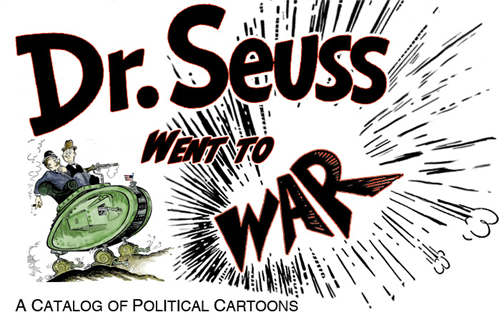Dr. Seuss Went to War: A Catalog of Political Cartoons.https://library.ucsd.edu/speccoll/dswenttowar/. Created by Richard H. Minear, The University of California,https://library.ucsd.edu/speccoll/dswenttowar/. Reviewed Apr. 2019.
Trench warfare, Pacific battles, and enslaved populace are common themes when one thinks about WWII. Often Overlooked are other areas influential to the thoughts and emotions associated with the war. Much of these emotionswere incubated on the backs of visual propaganda. The most widely known examples of propaganda are those used by the Germans in portraying allied forces in a negative light. Lesser known–are the war illustrations of Theodor Seuss Geisel, more commonly known as Dr. Seuss. A far stretch from Green Eggs and Ham, the collection of illustrations catalogued on Dr Seuss Went to Warare reminiscent of Geisel’s personal and emotional take on the war from 1941 till 1943, while working as chief editor cartoonist at the liberal-leaning, New York newspaper PM.
First, I’d like to address the layout of this site. The University of California at San Diego did an excellent job at cataloging the work of Geisel into relative sections so that viewers can go directly to the specific areas that interest them. Dr. Seuss historian, Richard H. Minear, reproduced two hundred of Geisel’s cartoons which he divided into seven sections. Sections are divided by year—1941 through 1943—and by people, places, issues, and battles. In his introduction, Minear mentions that the entire collection of Geisel’s work has been digitalized for this website. Text and background illustrations decorate the site in a style familiar to those who know Dr. Seuss. I assume this is to prepare visitors for the humor and joy that so many fans remember and love.
As part of the three sections making up 1941-1943, Minear separates each year into subcategories labeled for the twelve months of the year. One thing that isn’t very clearly explained is the absence of time, in the form of months, as some years are only represented by a few months, where others are represented by twelve months. This is questionable when understanding that, the PM news-paper was a daily news-paper which ran from 1940 to 1948. By this calculation, it is easy to see that the two hundred illustrations posted here do not make up three years’ worth of work by Geisel. Minear does not clarify a reason for these gaps in time. As a viewer, I can only speculate the lapses in time correlates with the more unfavorable periods of the United States involvement in the war.
The remaining tabs, particularly the people, places and issues tabs, each provide an assortment of flexibility. Regardless of your level of knowledge on WWII, any of these tabs would lead the viewer to comics which entertain.
Within each, the viewer will find well recognized topics such as: Douglas MacArthur, Adolf Hitler, German, Japan, Normandie, and Propaganda. Also included are lesser known topics such as: Lend-Lease Act, Syria, Iceland (In WWII? How surprising!), Frank Knox, and William O’Dwyer.
My personal favorites were the People and Places tabs. As mentioned above, topics under the people and places tabs are filled with names and places unheard of to the amateur historian. For those interested in both WWII and Dr. Seuss, this is the place to start when visiting this site. Another really impressive aspect of this site, from more of an academic perspective, was the inclusion of metadata for all 200 illustrations included. Some of the more prominent information found here includes: Title of (illustration), Creator, Publisher, and Date of Publication. Of those I checked, each even includes a pre-created citation to be used in bibliographies.
Overall, the compilation of work by Theodor Seuss Geisel that Richard H. Minear presents in this site, provides the viewer an alternate perspective on a war much discussed though often taught biasedly.

